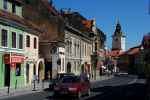
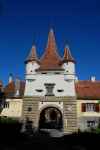
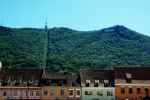
Brasov (Romanian: Braşov) is one of the most important and the most beautiful cities of Transylvania. It is located about 166 km north of Bucharest and having around 300 thousand inhabitants it is the eighth in terms of size city in Romania. The current name of the city – Braşov – is probably derived from a Turkish word barasu, meaning just white water.
ATTENTION! Everyone who visited Romania or is planning to go there soon is kindly invited to contribute to this guide. Any inquires regarding this matter should be referred to the editor's address redakcja@libertas.pl.
The traces of settlement in the Brasov area date back to the Bronze Age, but the origin of the city is connected with the arrival of the Teutonic Knights, brought to Transylvania (German: Siebenbürgen – 'Seven Cities') by Hungarian King Andrew II in order to defend the country against the pagan Kipchaks. In the year of the Lord 1211 the Teutonic Knights founded three settlements in present-day Brasov area: Kronstadt also called Corona interchangeably, in Latin (more or less where the Black Church stands today), as well as Martinsberg and Bartholomä. Because of a convenient location, near the ridge of the Carpathians and the passes, through which the trade routes from the east to the west led, the town grew reacher and expanded fast. It gained in importance even more when in 1395 King Sigismund of Luxembourg ordered to fortify Brasov, as a result of which thick walls and a system of gates and defensive towers were built.
In 1918, after World War I ended, Transylvania – or Siebenbürgen, if you like the German name better - was annexed to the Kingdom of Romania. In 1950, like many other cities in those times (e.g. Katowice, Poland), to memorialise immortal comrade Stalin, Brasov was renamed as Oraşul Stalin, or Stalin City. Like many other ‘undying’ ideas, however, also this one didn't survive for too long, and after a couple of years the old name was reintroduced.
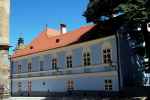
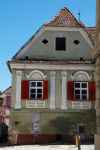
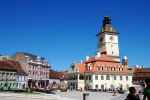
The city is signed very well, so with no slightest problem, and just with pleasure rarely experienced in such situations, everybody should find their way to the old town. On the main square – Piaţa Sfatului – we will see a monumental, late Gothic town hall from 1420, and a 58-metre high watchtower from 1528, adjacent to it. The square is encircled by very nice little tenement houses representing different architectural styles.
Among the buildings, northeast of the town hall, the neo-Byzantine-style Orthodox Church of the Birth of the Mother of God, built in 1896, 'hides itself'. In order to enter it, we have to pass through the gate, and then through a small yard. If it happens to be Saturday, you have a chance to see a wedding ceremony, which is obviously different from those we watch in our churches: as it can be seen in the photos, the young couple, for example, will walk three times around the altar...
On the subject of the wedding ceremony we may read, i.a., in the book by Princess Ileana of Romania1, the vast excerpts of which I will let myself quote:
The dress I loaned Anna to be married in was made in the age-old characteristic style of Bran. The wide, black wool skirt was paneled up the front with a wide strip of red and gold embroidery, and the wide-sleeved white linen blouse was also embroidered in red. On her head, covering her dark hair, she wore the long, transparent, scarflike wedding veil called marama, sheer white linen beautifully patterned in the weaving, which she would wear with dignity all her life on fete days, and be buried in — signature of her married state. (...) In Romania, a bride always wears beteala — bright strands of spun gold twisted about her head over the wedding veil and falling over her shoulders like a shower of golden hair. It is a very old custom; no one knows how or where it originated, but it is believed to date back to Roman times, as do many of our obscure customs. Conceivably, beteala could have represented the bride's dowry. No Romanian bride, even today, would be married without her beteala, no matter what type of wedding gown she might choose—the lovely traditional peasant dress, so becoming to all women, or the latest, smartest thing from Paris. She just would not feel herself a bride.
The priest heard our voices as we approached, and he was waiting for us at the door of the church clasping the Holy Book in his hands, the sun glinting and shimmering on his beautiful golden vestments. (...) Our little wedding company walked together down the footpath across the meadow to the church door, to meet the priest. He held the Book out to us; we reverently kissed it and then followed him as he turned and went inside, moving slowly and solemnly to the center of the church where a table had been placed. There are no pews in an Orthodox church. Worshipers stand or kneel, sometimes through services that are hours long in the great churches. Nor, contrary to Western churches, are wedding ceremonies performed at the altar. The table in the center of the church was covered to the floor with a large piece of purple and gold brocade, part of the vestments with which my mother had equipped the little church when she brought it to Bran. The priest placed the Bible on the table. There was a cross there, too, and a little tray holding two wedding rings, a goblet of wine with a silver plate containing two or three biscuits, and, most important of all, two golden crowns. The wedding guests stood decorously about the table at a respectful distance. Anna and Iosef stood together by the table facing the altar, Anton stood beside Iosef, and I beside Anna. Anton and I each held a lighted candle. The priest faced us, and the betrothal ceremony began. After prayers, the priest picked up one of the rings from the table and touched Iosef's forehead with it, saying, "The servant of God, Iosef, is betrothed to the servant of God, Anna." This he repeated twice and placed the ring on Iosef's left hand. Then he turned to Anna and, taking the other ring, touched her forehead with it in turn. "The servant of God, Anna, is betrothed to the servant of God, Iosef," he intoned, repeating it twice. After this, according to the ancient ceremony, I put down my candle and exchanged the rings, putting Iosef's on Anna's finger, and Anna's on Iosef's, making the sign of the cross with each as I did so. Then I returned to my place beside the table and picked up my candle again. Anna and Iosef joined hands. Then the priest ceremoniously lifted one of the golden crowns in his hands and touched Iosef's forehead with it. "The servant of God, Iosef, is wed to the servant of God, Anna," said the priest three times, and with Anton's help he placed it on Iosef's head. He lifted the other crown and touched Anna's forehead with it. "The servant of God, Anna, is wed to the servant of God, Iosef," announced the priest, three times, and in turn, I helped him to place it on Anna's bowed head, over her wedding veil and resting on the twisted beteala. This crowning was the great moment of the ceremony; symbolically, it was the crowning moment of their lives. The bride and groom then walked slowly and with dignity three times around the table, a symbolic dance of joy; its origin goes far back in time, indeed, into the Old Testament. The crowning accomplished, the priest then lifted the goblet and gave Iosef and Anna each a sip of wine, and, still wearing their golden crowns, they shared a biscuit from those on the little silver plate. This part of the wedding ceremony is in memory of the wedding in Cana of Galilee where Christ, Who is our High Priest, performed the first miracle of His ministry, that of changing water to wine when His mother whispered to Him that the wine provided by the host had given out. Also, it is symbolic of the couple's first shared meal together in their wedded state. Then the crowns were removed by the priest with the aid of the bridesmaid and groomsman, reverently kissed by the four of us and deposited on the brocade-covered table. At last, after the interminable prayers, the priest proclaimed them man and wife and blessed them with the sign of the cross. Immediately, there was great rejoicing among the guests. They surrounded the young couple, shaking hands and kissing them, embracing and congratulating them.
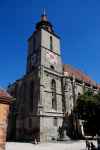
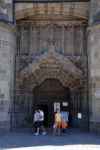
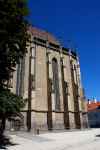
When on Piaţa Sfatului, it is hard not to notice a massive silhouette of the Black Church. Its construction started in 1383, in the place where stood the former church, destroyed during the Mongol invasion in 1242. The site probably wasn't lucky, since in 1421 unfortunately, when the works had been coming to an end, the Turks raided the town, causing serious damage. When the danger was over, the construction was restarted anew, and the church was consecrated in 1477. Two towers had been planned, however only one was built in the end, in 1514.
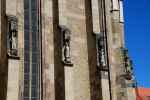

In 1689 a great fire, which consumed the bigger part of the town, broke out. It didn't omit the temple, either: the wooden equipment of the church was burnt down, and its walls turned black. Since then, the church is called Black. Inside we will see, among other things, an organ from 1839, equipped with 3993 pipes, the biggest in Europe collection of carpets from Anatolia, a baptismal font from 1472 and many others.
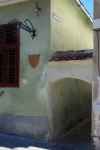
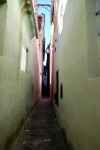
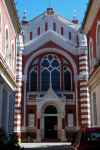
Heading south from the church, we get to the Poarta Schei Street, and then we turn right, south-west. More or less at the Black Church level we should find the famous little Rope Street, or String Street (Strada Sforii) turning left. It is the narrowest street in Europe, merely 1.32 metres wide and 83 metres long! It is so narrow that it basically looks more like a gate, so you must watch out that you don't miss it. Going farther down, we pass a synagogue from 1901 on the left, and we leave the medieval centre of the city, passing through a classicistic gate from 1827, built in the form of a triumphal arch.

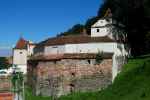
Just behind the gate we turn left (into Tiberiu Brediceanu alley), and going past some sports complex with tennis courts, we get to the 16th century Weavers' Bastion – it is the best preserved bastion of all seven town bastions. At the foot of the mountain there is a very pleasant park. Walking down its alleys, one may see well preserved fragments of old fortifications erected from the end of the 14th century until 1641. In the park there is also the lower station of the cable railway, by which one can get up to 960 metres above sea level.
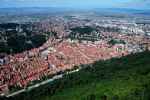
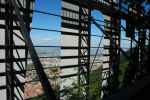
To the top of the mountain one can get on foot (c. 40 minutes), or take the cable car ride. A return ticket costs 13 lei (the reduced one – 7 lei). On the hill, on the area of c. 1.5 km² extends a nature reserve, in which bears, among others, live! From the top extends a beautiful view of the entire city. It is worth going here.
The area in the vicinity of Brasov is certainly not lacking in hotels and cheaper motels. I would particularly like to recommend two of them, with which I had some contact. Of course, if anyone has any comments on other places, then we will gladly broaden the list.
At the 165th kilometre of the Bucharest-Brasov route there is the three star Motel Timisul De Jos Brasov, in which a triple room cost 150 lei per night. Unfortunately, when we arrived, all rooms for three were taken, and two double or twin rooms turned out too expensive. On the other hand, the gentleman working at the reception desk was very kind and obliging, that is why although we didn't stay overnight here, I am sure the motel is worth recommending.
Ten kilometres farther, at the same route, on the outskirts of Brasov (opposite a big Peugeot showroom) there is the two star Motel Darste Brasov, where for a room for three we paid 100 lei. It was very clean and pleasant, so I warmly recommend it as inexpensive accommodation practically in Brasov.

Just next to the Black Church there is a small tavern where one can eat very tasty and inexpensive breakfast. We were tempted by a clever slogan: The sandwichshop is not fast food! Is good food fast!
We ordered a Greek salad with grilled sandwiches and it was equally tasty as fast... I recommend them.
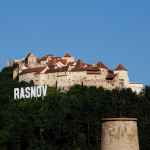
Rasnov is a small town located about 15 kilometres southwest of Brasov, so more or less halfway in the direction of Bran. The castle towering over the city was built by the Teutonic Knights around 1215. After they had been chased away by the king, the local peasants took over the stronghold, enlarging and strengthening it themselves later on. It is, therefore, so called peasant castle, and as a result of it, we will not find here any edifices typical for the castles of aristocrats; all in all, it was to serve only as a shelter in case of an attack (e.g of the Turks).
In the castle every family had a room, where they could store provisions, and live in there in case of a danger. It paid off. In the course of its entire history the castle was conquered only once, in 1600, by the prince of Transylvania, Gabriel Bathory, a grandson of Andrew – a brother of the king of Poland, Stephen Bathory.
One legend is attached to the castle. So when during some siege the dwellers started to suffer the lack of water, they ordered two Turkish captives to dig a well, promising them freedom in return. The prisoners dug for 17 years, but in spite of that they were killed later on. The well exists until today and is 143 metres deep. And, in passing, it is interesting that similar legends about a well dug by prisoners are attached to many castles, for example to the Corvin Castle in Hunedoara.
The first wooden castle in Bran was built yet by the Teutonic Knights, at the same time when Brasov was being founded. That castle was completely destroyed during a Turkish raid in 1370. The one which we see today was built between 1377 and 1382 by order of King Ludwig of Hungary, already of stone and brick in the Gothic style. The castle gained the present, more renaissance look during its reconstruction after the fire of 1619.
For a long time the object was advertised as the Dracula's Castle; it is almost certain, however, that the prototype for this literary character – famous Vlad the Impaler – had never even been in the castle, not to mention owning it. Only recently this disinformation ceased to be practised, but tourists still come here in great numbers, and at the castle there is a huge (maybe the biggest in Romania) bazaar with souvenirs related to Dracula.
Among all of the royal palaces and castles there is one that is very special. And that not only in Roumania. There is in all Europe no other royal residence so romantic. Castle Bran is in the far fastnesses of the Carpathians. It stands right against the sky, rising precipitately out of the very crown of a mountain peak. The name means a "gate" and it is so called because it guards the mountain pass below. This is the very old fortress with which the Saxons defended this part of Europe against the Turks. Inscriptions on its foundations show that it stood here in the year 1200, and how much older than that it may be no one can tell.2
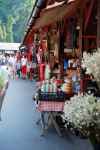
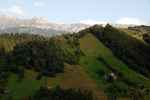
The Carpathians separate Transylvania (Siebenbürgen) from Wallachia. We are going from Brasov to Curtea de Argeş, so we are crossing the natural border which runs, as I suppose, somewhere between Bran and Câmpulung. The views are so beautiful that it is difficult to take one's eyes off them. Every now and then we are pulling over somewhere for a moment, to look, to breathe. Not only we... once in a while we are meeting the others travelling the same way, who couldn't refrain from it...
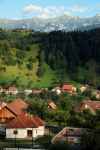
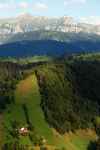
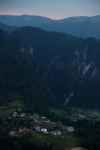

One may additionally beguile their ride by trying different local specialities, let's add that not examined by the European Union officials so far, and not coming up to any less or more idiotic standards. Maybe that is why they taste significantly better! We bought for ourselves a couple of sausages from bear and wild boar: they were very well smoked and awafully tasty! After a quickly organised and completely unhygienic degustation we bought two one and a half litre bottles of delicious homemade juice (of different sorts) and a bunch of pretzels. And you won't believe, but we are alive! Seriously!
Princess Ileana of Romania, Hospital of the Queen's Heart, New York, 1954.
Mabel Potter Daggett, Marie of Roumania: The Intimate Story of the Radiant Queen, Murray Hill (New York), 1926.
Rumunia - przewodnik:
Satu Mare / Satmar (Romania) – guidebook (52 zdjęcia)Săpânţa - The Merry Cemetery (Romania) – guidebook (35 zdjęć)Bârsana Maramureş (Romania)– guidebook (48 zdjęć)Humor / Mănăstirea Humorului and Voronet / Voroneţ (Romania) – guidebook (32 zdjęcia)Arbore and Sucevita Monastery / Mănăstirea Suceviţa (Romania) – guidebook (43 zdjęcia)Cacica (Romania) – guidebook (21 zdjęć)Vama Veche (Romania) – guidebook (94 zdjęcia)Brasov (Romania) – guidebook (68 zdjęć)Curtea de Argeş (Romania) – guidebook (31 zdjęć)The Transfagarasan Road / Transfăgărăşan – guidebook (68 zdjęć)Sibiu / Hermannstadt (Romania) – guidebook (86 zdjęć)Hunedoara / Vajdahunyad (Romania) – guidebook (57 zdjęć)Bear Cave / Peştera Urşilor (Romania) – guidebook (29 zdjęć)Ştefan Hruşcă – kolędnik z SiedmiogroduSighetu Marmației (Romania) – guidebook (9 zdjęć)Kościoły Obronne Siedmiogrodu (Rumunia) – przewodnik (25 zdjęć)Rimetea / Torocko at the Rock of Szeklers (Romania) – guidebook (21 zdjęć)Konstanca / Constanța (Rumunia) – przewodnik (22 zdjęcia)Sighișoara (Romania) – guidebook (28 zdjęć)Mărginimea Sibiului (Romania) – guidebook (41 zdjęć)Wąwóz Galbeny / Cheile Galbenei (Rumunia) – przewodnik (23 zdjęcia)Twierdza Ponoru / Cetatile Ponorului (Rumunia) – przewodnik (19 zdjęć)Płaskowyż Padisz / Padiș (Rumunia) – przewodnik (52 zdjęcia)Wąwóz Râmeț / Cheile Râmețului (Rumunia) – przewodnik (29 zdjęć)Góry Fogaraskie – wokół jeziora Bâlea (Rumunia) – przewodnik (24 zdjęcia)